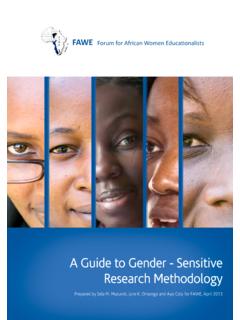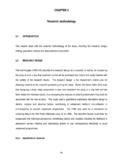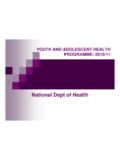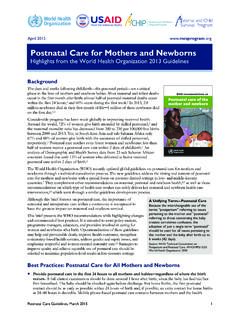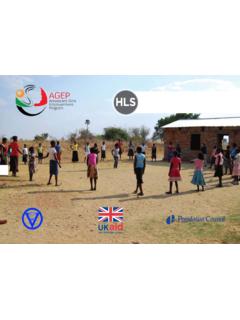Transcription of SCHOOL RE-ENTRY FOR ADOLESCENT MOTHERS
1 Ii PREFACE Various interventions have been undertaken to address the gender gaps in the education sector. Significant achievements have been scored through these initiatives towards improving girls' access, retention and performance. However, the gender disparities are still wide. It is clear however, that unless quicker and strategic action is taken to address these gaps, EFA goals are unlikely to be achieved. One strategy that is being proposed is to take successful interventions to scale in order to ensure that a higher number of girls are reached. This has so far not been adequately undertaken. As a first step towards scaling up best practices, it is necessary to identify and document the most successful interventions in a way that can be taken up by education policy makers and other stakeholders.
2 One of FAWE's strategic objectives is to influence replication and mainstreaming of best practices. FAWE has undertaken to document its best practices with the aim of disseminating them to education policy makers and influencing mainstreaming of these interventions into education plans and programmes. FAWE, with its partners, will be holding a Ministerial Consultation in June 2004. This booklet traces the evolution of the RE-ENTRY policy in Zambia and emphasizes the seriousness of having in place clear guidelines and a tracking and monitoring system for its implementation. While many countries now recognize the importance of giving ADOLESCENT MOTHERS a second chance to continue with their education and pave a future for themselves, only a handful have RE-ENTRY policies in place.
3 And among those who have, many have failed to systematically monitor the impact of the policy. The FAWE Zambia chapter (FAWEZA) has successfully worked with the Ministry of Education to develop clear implementation guidelines, disseminate them and assess their effectiveness in improving girls education. FAWE hopes that this experience will inspire the replication of this best practice far and wide in sub Saharan Africa. Penina Mlama Executive Director iii Table of Contents Girls Education in Zambia 2 Readmission of Girls who Leave SCHOOL because of Pregnancy 4 What Makes it a Best Practice? 14 Lessons Learnt and Challenges 16 Implications for Scaling Up 18 Conclusion 23 Case Studies 25 Forum for African Women Educationalists is grateful to Mrs Monde Sifuniso for documenting this Best Practice KEEPING GIRLS IN SCHOOL FAWE Zambia s Campaign for an Enabling Readmission Policy for ADOLESCENT MOTHERS Every now and again the world as a community of nations looks into the future and sets a goal to be achieved by a certain year.
4 The year appears far enough into the future for every country in the world to reach the goal by the stated time. So it was that in 1990, at a conference held in Jomtien, Thailand, the world set 2000 as the year by which it would achieve universal primary education for all and equity in education. As the magical year drew nearer, it was clear that most African countries south of the Sahara were not going to reach the target. But it was not for lack of trying, especially in the area of gender equity. Many countries had adopted strategies to promote girls education. Many countries had also increased spending on education. Expenditure on education (as percentage of GDP, 2000) Angola (in spite of the civil war) Botswana Malawi Namibia South Africa Swaziland Zambia Zimbabwe At the Education for All World Conference held in Dakar in 2000, the goal posts were moved to 2005 for the elimination of 2 gender disparities in primary and secondary education.
5 A second goal was for governments to ensure girls full and equal access to and achievement in basic education of good quality by the year 2015. GIRLS EDUCATION IN ZAMBIA When missionaries introduced Western education in Zambia in the late 19th Century, only men and ADOLESCENT boys were admitted to schools. This was utilitarian education that benefited the missionaries themselves. Only practical subjects such as gardening and carpentry were offered. The Three R s were added to the curriculum later so that the new converts would be able to read the Bible and Christian tracts for themselves. In 1924, the colonial government took over the running of schools from the missionaries and extended the SCHOOL period to eight years. In the mid-1930s education for women was introduced.
6 The curriculum for women was different from the men s. Women were offered cooking, baby care, hygiene, sewing and nutrition. Their education prepared them for their roles as wives and MOTHERS . From the very beginning, therefore, men had a head start, and they were offered education that was superior to that offered to women. This trend continued well into the independence period, when there were more SCHOOL places for boys, and technical subjects were offered to boys only. In addition, there were, and still are, more barriers for girls to surmount in order to access education. Some of the barriers are SCHOOL -based. They include: SCHOOL location long walking distances that tire girls out and expose them to sexual abuse. 3 Girls low levels of achievement, in comparison to boys, which makes parents feel that the time girls spend in SCHOOL is wasted.
7 SCHOOL infrastructure poor sanitation that affects girls much more than boys. Other barriers are community-based: Poverty - when parents decide to send sons to SCHOOL rather than daughters. Household chores and other community duties, which keep girls out of SCHOOL and divert their attention from learning. High levels of illiteracy, especially among women ignorance begets ignorance. In addition, Zambia continued to spend less on education than other countries in the region. This indirectly affected the education of girls because it meant more dilapidated infrastructure, poor sanitation, not enough SCHOOL places all factors that militate against girls access to education. One other barrier, as girls grew older, was pregnancy.
8 Girls who became pregnant were expelled from SCHOOL and were not re-admitted into the SCHOOL system. (It should be remembered that until the 1970s, teachers who got pregnant outside marriage were also fired and blacklisted.) There were some girls who became pregnant after being raped. In many cases, girls were made pregnant by fellow students. These boys were also expelled, if they were reported to the SCHOOL authorities. In the majority of cases, the boys were not reported and they continued with their education. There was always the promise that the boy, if allowed to complete his education, would be able to take better care of his child, and probably marry the mother. They rarely did. In a few cases, the culprit was a teacher. Again, a teacher could be disciplined if reported, but few were reported.
9 4 Therefore, while schoolboy fathers stayed on in SCHOOL , irresponsible teachers continued to prey on children put in their care, and male predators stalked girls, the young MOTHERS were sentenced to a life of misery in the innermost circle of poverty reserved for uneducated single MOTHERS . When the women s movement in Zambia grew in strength, one of the issues they decided to fight for was justice for girls who were thrown out of SCHOOL after getting pregnant. In June 1995, the Zambia Association for University Women organized a conference on the situation of the girl-child in Zambia. The conference, which was held in preparation for the Fourth World Conference on Women, proposed to government that girls who became pregnant should be re-admitted into SCHOOL once care for the child was assured.
10 This was the launch pad for the RE-ENTRY policy. READMISSION OF GIRLS WHO LEAVE SCHOOL BECAUSE OF PREGNANCY After the Beijing Conference in 1995, the Women s Movement drew up its own priorities and action plan. Under education for the girl-child was a call to readmit girls who dropped out of SCHOOL due to pregnancy. When the Forum for African Women Educationalists of Zambia (FAWEZA) was established on 8 March 1996, it added its voice to the call for policy change concerning girls who got pregnant. In September 1997, a conference on girls education was held at Mulungushi International Conference Centre, Lusaka, at which the Minister of Education, Dr. Syamukayumbu Syamujaye, announced that schoolgirls who became pregnant would no longer be expelled, and that those that had been expelled in 1997 should be allowed to return to SCHOOL .
